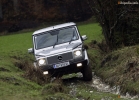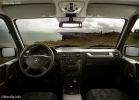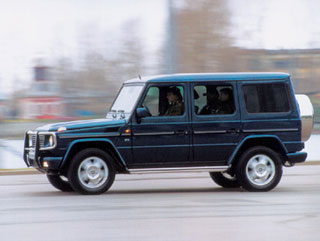Test drive Mercedes Benz G-Class 2000-2007 SUV
David and Goliath
In fact, comparative tests in which automobile journalists are usually trying to find the most worthy candidate for leaders among many modest models, we are not in fundamental: there is no sense. To compare two approximately the same cars, to look for disadvantages-domestic in them, to draw some conclusions based on subjective opinions-the matter is so ungrateful that I do not want to take it up. Moreover, both representatives of the firms and their customers will still remain in their opinion: each car has their own advantages and disadvantages, and it does not happen so that everything is fine and cheap or, conversely, expensive and terrible. The only question is how much this or that model is suitable for a specific buyer, meets its requirements and arranges it in several basic parameters: someone is important to the fuel consumption and the volume of the trunk, and someone primarily pays attention to controllability and dynamics. That is why the results of comparative tests can be considered only as a superficial recommendation, and not a reason for buying: each of us has its own priorities and concepts and good and bad.Nevertheless, sometimes it is simply impossible to refuse a comparative test, if one can be called today: too similar and at the same time different cars, so I want to show these very differences by example. Although, using the example of these two models, the Mercedes -Benz - G500 and ML 270 CDI will not have to be shown anything. The differences are so obvious that they are immediately striking. And about how these models are different, how they behave in various conditions and why they are, in fact, intended, we decided to tell in this material. So to speak, demonstrate a visual example of a different approach to constructing vehicles of increased cross -country ability. Two immigrants from different eras, a veteran and a young athlete -tank - a real rogue and a fashionable sabotage tract, whose off -road qualities, about the off -road qualities of which can only be guessed. Each of them has their own outlook on life, each has its own priorities, their own advantages and disadvantages. It remains only to choose what you like ...
So, Mercedes-Benz G-class. He is Gelandewagen, which in a free translation from German means an all -terrain vehicle. This model, I think, does not need to represent anyone: for more than a 20-year career, the G-class managed to gain authority among buyers around the world. By the way, in the States, this model is considered a car for millionaires - its cost goes off for a hundred thousand dollars! Although, on the other hand, in Moscow it costs about the same, and judging by the abundance of these cars there, mainly in AMG versions or tuning from Brabus, Lorinser, etc., our neighbors also do not poor.
And it all started quite prosaic. The starting point for creating this cult model was the order of the German military department, which needed a utilitarian SUV, a simple in design, very reliable and unpretentious. The development of this car was conducted by Mer-Cedes-Benz together with the Austrian company Steur-Puch, and mainly the Austrians worked-the Germans had not yet had appropriate experience in this area. That is why the first G-class that appeared in 1979 was called in a completely different way and did not even carry a Mercedes star-it was called Steur-Puch Explorer. This model was produced (and is still produced) at the factories of the Austrian company - Daimler- Chrysler has no relation to production. Directly, as Mercedes G-class, this model lit up only a year later, under the branded W460 index- with three- and five-door bodies, including as a convertible. Ten years later, in 1990, the model received the W463 index and a light restyling was passed: small external changes plus a significantly updated interior borrowed from the concern's passenger model. And this year, Mercedes, then Daimlerchrysler, presented the next generation of the Gelandewagen model - with the former, slightly toned with appearance and a completely new interior - from the new S -class (W220). It is such a car, the latest generation, with a 5-liter engine, a leather interior and a full package of additional equipment and came to us for a test. Its opponent, Mercedes-Benz ML 270 CDI, cannot boast of either a career, because of his youth, nor fame. But he has absolutely incredible running qualities for the SUV, comfort and handling. Well, let's check ...
It is perhaps worth starting the story of sledding cars of cars from listing the structural features of these two models, because it was they who determined the presence of such different characters.
So, the G -class is the most real SUV. The frame on which the body rests, a constant all -wheel drive, a low row of transmissions, the ability to block all three (intended and inter -coil) differentials plus dependent suspensions of the front and back. What is a dependent suspension? This is the Balka-Most that you could see on domestic rear-wheel drive machines or on UAZs, in other words, a heavy metal case for differential and semi-shafts. For ML, everything is exactly the opposite: the suspensions of all the wheels are independent, there is a permanent all -wheel drive, but there are no differential locks (they are replaced by an electronic imitation), although one of the signs of a real SUV is preserved - a spar frame to which the body and suspension are attached. Naturally, with such differences in the design, cars drive in completely different ways, and for this it is not even necessary to sit in them. Just look at the G500 and ML standing nearby to notice the differences. The first looks like a tall square idol against the background of the second, chubby and squat. Naturally, the height of the car primarily depends on the road clearance - the distance between the road and the lowest part of the car located. ML has this same road clearance, it is also called clearance, is 200 mm, and the G500 has 220. The difference seems to be small, if not more - insignificant, but that’s all the salt that ML these numbers indicate the distance To a low hanging unit, and Galande -Wagen has a steel protection that reliably covers all the nodes. As you can clearly see in the photo, the G500 looks more prepared for off -road adventures: it has minimal overhangs in front and back, strong steel bumper and powerful protection. The more delicate ML 270 CDI has plastic, strongly protruding bumpers, large overhangs and low hanging mudguards - if you like jeep -trial, then all this farm can remain on the highway. By the way, attentive readers probably noticed that the ML depicted in the photo is not new. To date, the production has an updated model with transparent lighting technology, updated bumpers and many other small changes. Unfortunately, such a car could not be found for the test, but this is not significant: there are few serious constructive differences that could affect cross -country ability or controllability, so the previous ML is quite suitable for comparison.
Testing of all -wheel drive cars of increased cross -country ability is best to start with impassability, and we did just that. Why, in the end, to buy such a car if there is no desire or skill to drive through the crossed terrain. And as soon as an uneven soil road was under the wheels, it immediately became clear how much these two cars were varying. Where the huge square of the G500 was easily and at ease at a decent speed, not paying attention to the bumps, the driver ML had to be careful. The energy intensity of pendants is so different that having traveled for some time at the G-class, you can easily ditch ML on the off-road, as you are accustomed to a professional’s indispensable suspension, you can put the SUV on a stone or snag from all the way. Again, you will have to go through all the obstacles very carefully, so as not to bend the levers of independent pendants. It is much easier to go to the G500: if there is no vertical wall or boulders of a huge size on your way, then you can move on the principle: more gas is less than the pits. You can take a fool away at the entire speed across the track - the car will jump, but you will not be able to break the suspension. Dependent Bridges, which in the past generations of this model were attached on the springs, withstand such blows that any SUV would have long been twisted into the pipe, firing in goodbye to all the curaments. And at the same time, the car is quite comfortable: a powerful frame extinguishes all the blows and vibrations, and therefore when passing obstacles you do not feel at all how difficult the car is.
Another thing is ML - for every attempt to let him in the trace of the G500, he meets the incredible number of unpleasant sounds of sounds: the motor roars (there is not enough traction), the suspension is working out the bumps with such sounds, as if all the levers have already remained on the road, and indeed the feeling, in general, the feeling, That the car may not be enough until the end of the road. But this is only a feeling - Mercedes, even if it is a SUV, still remains a Mercedes, and ML quite successfully copes with obstacles. Although some of them are still better to go around. A typical example: a pipe -half -dug in the grounds of a soil road - either some kind of drainage, or ordinary sloppiness. The G500 rushed along the puddles only slowed down, and slipped, and the driver of ML, who was traveling next, had to prepare for this maneuver more thoroughly - to choose an angle of attack, and even plant a passenger so that he would correct it (if that). But even such precautions did not help: ML still cursed in all four sprayers that all participants in the dough had to worry. Fortunately, the case was just indicative. We moved an obstacle with all the precautions, and even under the leadership of the navigators, and if the driver will go alone?
We go to the asphalt, and the situation changes exactly the opposite: now the light and brilliant ML feels like a leader, making the old G500 sweat a little. And although the veteran of the O-hoh motor, in the sense of almost twice as powerful, and even an eight-cylinder, this does not save him: it is too off-road initially in its design. And this means that everything that helped him off -road so easily and at ease to move, interferes with the asphalt. Why, tell me, do you need such a huge road clearance on the highway? It’s good, of course, when you can fearlessly skip between the wheels the protruding well hatch or to jump on the curb, but the reasonable question arises: do you often do this on your car? It is for us, painted automobile journalists, it does not cost anything to humiliate an SUV worth almost a hundred thousand dollars, forcing him to tinker in mud or jump on a leapway, but the owner is unlikely to ever do this. If only because with the slightest damage to the car, he himself will have to restore it. On the other hand, and to us too ...
By the way, despite the fact that under the hoods of these cars there were engines of various types, power and volume, under normal conditions of movement, none of the models had a particular advantage. Yes, on the G500 with an eight -cylinder gasoline engine with a capacity of 300 horses, you can ride very quickly, especially since it takes only 7.3 seconds to accelerate to hundreds even at a heavy five -door version! But it’s not possible to go on it quickly: you can’t particularly jump with dependent pendants along our roads. No, the five -hundredth is normally steer - it does not scour at high speed, it is quite normally in turn and generally rides well for a professional. But it’s scary to cut between cars: you sit very high, so you feel all the rolls and you feel perfectly, especially on braking, when a tall G500 pecks with your nose. And this, you understand, does not add confidence: you involuntarily begin to increase the distance to the car walking in front, especially if it is a good BMW. The driver ML 270 CDI, as if in revenge for humiliation on the off -road, easily breaks forward, and there is no desire to chase after him. In which case this two-ton colossus itself will not stop instantly and a couple of cars will bring down in front of him. I sympathize with these guys from the motorcade who drive on such cabinets for swift limousines ...
As you can see, these two almost the same outwardly, for an ordinary motorist, the car turned out to be very different in the course of real operation. Where one shone, the other behaved mediocre, but the design features allow them to be very capable of everyone in their elements. And the fact that two such completely different cars are produced by one manufacturer clearly demonstrates trends in the world automotive industry. All manufacturers of all -terrain vehicles were divided into two camps: some produce professional vehicles of high cross -country ability, while others are fashionable and fashionable and in increased demand for SUVs. And some firms, as you can see, manage to work on two fronts. For comparison: the total circulation of all professional all -terrain vehicles produced by all firms in the world is about 100-150 thousand copies annually - despite the fact that UAZs are also included here. And the SUVs, the relatively young and very rapidly developing market segment, against this background, looks just stunning: the overall circulation today is calculated by millions! And this is only the beginning, since no decent car dealership is complete without the premiere of one or two new SUVs. But this does not mean that the era of professionals is nearing the end. The heyday of almost passenger SUVs does not mean at all that the real ones will be left without work - there are still enough places on this planet where you can only get on a real alternate ...
Text: Pavel Kozlovsky








